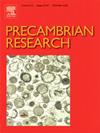挪威古裂谷带的同位素识别对芬诺斯坎地盾西南区硫化镍矿化的启示
IF 3.2
2区 地球科学
Q2 GEOSCIENCES, MULTIDISCIPLINARY
引用次数: 0
摘要
芬诺斯坎迪亚地盾西南部拥有重要的正岩浆型硫化镍矿床,与前斯威格世地壳演化有关。本研究综合了seconorwegian省Kongsberg单元新的U-Pb锆石年代学、Lu-Hf同位素数据和全岩地球化学数据,对其岩浆和成矿演化进行了研究。结果显示,在Kongsberg单元的三个杂岩中存在明显的岩浆事件,突出了显著的时间和同位素非均质性。东Kongsberg杂岩的岩浆活动限制在1610±11 ~ 1524±11 Ma之间,与哥特造山时期的火成岩活动同期,与弧相关的构造背景一致。同时,西Kongsberg杂岩在1528±9 ~ 1153±3 Ma之间记录了更年轻、更年轻的岩浆活动。其间的莫达姆杂岩则代表了伸展盆地的沉积发育;1475 Ma和1305±8 Ma和1185±12 Ma之间的岩浆活动。东Kongsberg杂岩的Ertelien(1584±19 Ma)和Langedal(1546±2 ~ 1524±11 Ma)矿床的硫化镍矿化主要与哥德式岩浆活动有关,而西Kongsberg杂岩的gr本文章由计算机程序翻译,如有差异,请以英文原文为准。
Isotopic identification of paleo rift zones within the Sveconorwegian Province; implications for nickel sulphide mineralisations in the SW Fennoscandian Shield
The southwestern Fennoscandian Shield hosts significant orthomagmatic nickel sulphide deposits linked to pre-Sveconorwegian crustal evolution. This study integrates new U-Pb zircon geochronology, Lu-Hf isotopic data, and whole-rock geochemistry from the Kongsberg Unit of the Sveconorwegian Province to investigate its magmatic and metallogenetic evolution. The results reveal distinct magmatic episodes across the three complexes of the Kongsberg Unit, highlighting notable temporal and isotopic heterogeneity. Magmatism in the Eastern Kongsberg Complex is confined between 1610 ± 11 and 1524 ± 11 Ma, coeval with igneous activity during the Gothian orogeny and consistent with an arc-related tectonic setting. Meanwhile, the Western Kongsberg Complex records younger, more juvenile magmatism between 1528 ± 9 and 1153 ± 3 Ma. In contrast, the intervening Modum Complex represents extensional basin development with sedimentation < 1475 Ma and juvenile mafic magmatism between 1305 ± 8 Ma and 1185 ± 12 Ma. Nickel sulphide mineralisation, including the Ertelien (1584 ± 19 Ma) and Langedal (1546 ± 2 to 1524 ± 11 Ma) deposits in the Eastern Kongsberg Complex, predominantly correlates with Gothian magmatism, whereas deposits in the Western Kongsberg Complex, such as Grågalten (1164 ± 13 Ma), are linked to later magmatic events. A pronounced westward-younging trend in zircon U-Pb crystallisation ages and Hf model ages supports a dynamic lithospheric evolution driven by long-lived crustal extension and subsequent Sveconorwegian orogenic assembly. Additionally, widespread platinum group element (PGE) depletion across the province suggests a pyroxenitic mantle source, rather than repeated sulphide extraction during magmatic differentiation. These findings emphasise the critical role of pre-Sveconorwegian lithospheric architecture and mantle source characteristics in controlling nickel sulphide mineralisation, offering valuable insights for future exploration strategies in the region.
求助全文
通过发布文献求助,成功后即可免费获取论文全文。
去求助
来源期刊

Precambrian Research
地学-地球科学综合
CiteScore
7.20
自引率
28.90%
发文量
325
审稿时长
12 months
期刊介绍:
Precambrian Research publishes studies on all aspects of the early stages of the composition, structure and evolution of the Earth and its planetary neighbours. With a focus on process-oriented and comparative studies, it covers, but is not restricted to, subjects such as:
(1) Chemical, biological, biochemical and cosmochemical evolution; the origin of life; the evolution of the oceans and atmosphere; the early fossil record; palaeobiology;
(2) Geochronology and isotope and elemental geochemistry;
(3) Precambrian mineral deposits;
(4) Geophysical aspects of the early Earth and Precambrian terrains;
(5) Nature, formation and evolution of the Precambrian lithosphere and mantle including magmatic, depositional, metamorphic and tectonic processes.
In addition, the editors particularly welcome integrated process-oriented studies that involve a combination of the above fields and comparative studies that demonstrate the effect of Precambrian evolution on Phanerozoic earth system processes.
Regional and localised studies of Precambrian phenomena are considered appropriate only when the detail and quality allow illustration of a wider process, or when significant gaps in basic knowledge of a particular area can be filled.
 求助内容:
求助内容: 应助结果提醒方式:
应助结果提醒方式:


